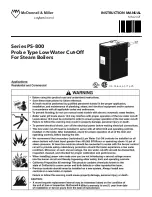
the lower bracket (1);
– disassemble the right side (4) following
the same operations.
3.3.4
Fault finding
Herefater we outline a number of potential
problems that may occur on the appliance
and the relevant list of actions required. A
working fault, in most cases, provocates
the “lock out” signal onto the control panel
of the control box.
When this light turns on, the burner can
operate again only after the reset button
has been pressed; if this has been done
and a regular ignition occurs, it means the
failure can be defined momentary and not
dangerous. On the contrary, if the “lock out”
stays, the cause of the fault, as well as the
relevant action must be made according to
the following chart:
The burner does not ignite
– Check the electric connections.
– Check the regular fuel flow, the clean-
ness of the filters, of the nozzle and air
vent from the tube.
– Check the regular spark ignition and the
proper function of the burner.
The burner ignites regularly but the flame
goes out immediately
– Check the flame detection, the air cali-
bration and the function of the appliance.
Difficulty in regulating the burner and/or
lack of yield
– Check: the regular flow of fuel, the clean-
ness of the boiler, the non obstruction of
the smoke duct, the real input supplied
by the burner and its cleanness (dust).
The boiler gets dirty easily
– Check the burner regulator (smoke
analysis), the fuel quantity, the flue
obstruction and the cleanness of the air
duct of the burner (dust).
The boiler does not heat up
– Control the cleanness of the shell, the
matching, the adjustment, the burner
performances, the pre-adjusted temper-
ature, the correct function and position
of the regulation stat.
– Make sure that the boiler is sufficiently
powerful for the appliance.
Smell of unburnt products
– Control the cleanness of the boiler shell
and the flue, the airtightness of the boil-
er and of the flue ducts (door, combus-
tion chamber, smoke ducts, flue, wash-
ers).
– Control the quality of the fuel.
Frequent intervention of the boiler shut-
off valve
– Control the presence of air in the sys-
tem, the function of the circulation
pumps.
– Check the load pressure of the appli-
ance, the efficiency of the expansion
tanks and the valve calibration.
3.4 FROST PROTECTION
In the event of frost, ensure that the central
heating plant is functional and effective
frost protection interlocks are in place to
protect against frost damage
3.5 USER
WARNINGS
When faults occur and/or the equipment
does not operate correctly, turn the boiler
off and contact the authorised service engi-
neer.
42
















































